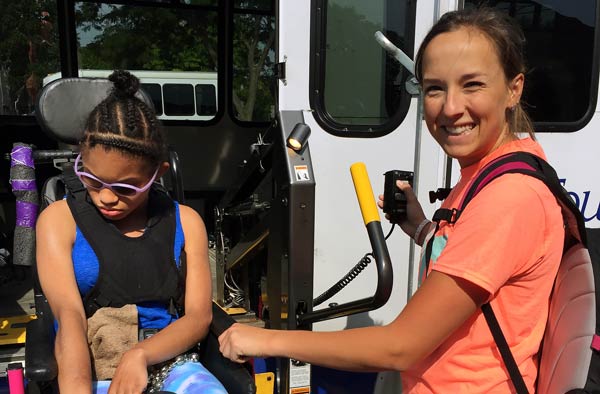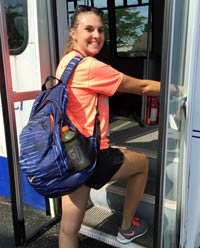 Reducing the Risks Improves Fleet Safety
Reducing the Risks Improves Fleet Safety
Special Recreation Association (SRA) staff spends a good deal of time transporting patrons to and from activities and locations that include unique exposures. Ensuring drivers receive regular training helps reduce those risks, keeping both staff and patrons safe.
A significant problem for every driver is the area behind a vehicle the driver can’t see — the blind zone — that can obscure people and obstacles. The larger the vehicle, the larger its blind zone. For SRAs, most drivers are behind the wheel of vans and/or shuttle buses, which are more than large enough to have problematic blind spots.
One PDRMA member met this challenge with a simple solution that not only saves the agency money in replaced tires but also earned it a 2012 Risk Management Grant and Recognition award — a Mirror Adjustment Station.
“During the summer, our vehicles (activity buses, mini vans and wheelchair accessibles) are almost constantly in use transporting some 1,800 participants to and from special events,” explains Dana Seehafer, Senior Manager of Operations at Northern Illinois Special Recreation Association (NISRA). “We were having issues with right-side tire damage because drivers would hit curbs.”
All that changed two years ago when NISRA set up the Mirror Adjustment Station. “A former school bus driver who worked for us told us how to identify and reduce blind spots by properly angling vehicle mirrors,” recalls Seehafer. “It required a special spot in the parking lot for drivers to check their mirrors for visibility. They couldn’t leave until they adjusted their mirrors to see the large colored dots painted on the pavement. Once they could see all the dots, they knew their mirrors were properly adjusted.”
Seehafer says it was easy to set up the station, and the paint cost only about $50. “We require all our drivers — we have 40 or 50 — to stop at the Mirror Adjustment Station every time before they leave NISRA. We also have special alternate training for our minivan drivers.”
Since using the station, NISRA hasn’t had to replace tires due to curb damage. Recently, they added a convex mirror to a light pole in the station, so drivers can check signal and brake lights without leaving the vehicle. 
Because NISRA offers door-to-door pickup, Seehafer reviews and plans the routes to make sure drivers proceed safely. “We know each particular house and plan for curbside pickups. Our drivers never pull into driveways, because we don’t allow them to back up; they always pull forward when leaving.”
During NISRA’s annual Fleet Safety Day, Seehafer provides specific training based on NISRA’s claim trends, such as distracted driving. All drivers must complete PDRMA’s online Defensive Driving course.
Warren Special Recreation Association
At Warren Special Recreation Association (WSRA), Warren Township actually owns and manages the buses the agency uses for its programs. “Currently, five of our full-time staff and 14 part-time employees are qualified and trained to drive,” explains Susan Young-Markey, CTRS, Superintendent at WSRA. “Our drivers are actively involved as program staff or program leaders, not just hired as drivers.”
That means WSRA has a unique training process. “Staff that demonstrates maturity, sound judgment and has a good driving record becomes WSRA drivers,” Markey explains. “Training includes our policies and procedures, wheelchair lift training, on-the-road driving, reviews and annual training. The training process takes a couple of weeks to complete.”
Annual training focuses on ergonomic stretching, the 30 Second Site Safety Walk Through, 3 Points of Contact, wheelchair lift use and tie downs, and participant transfers — always focusing on good body mechanics. “Many of the resources I use come from PDRMA, which makes finding appropriate ones easy for me.”
Northwest Special Recreation Association
Barb Bassett, Operations Coordinator at Northwest Special Recreation Association (NWSRA), has 32 full-time drivers and 22 part-timers — as well as 22 vehicles — to train and maintain. “Our training protocol for first-time drivers includes a thorough review of the vehicle manual, followed by vehicle training, adding up to about seven hours of initial training,” she explains. “If the person is a Commercial Driver Licensee, then there is additional training.”
 NWSRA’s driver hiring procedures require the applicant to have an acceptable Illinois driving record and to complete a drug screen. Once hired, full-time drivers participate in an agency-wide training their first month of employment, which includes designated times for vehicle training. In addition, there are refresher trainings throughout the year for both full- and part-time drivers. Those sessions include a review of policies and procedures as well as hands-on training for mirror usage, vehicle parking and proper backing, and pre-trip inspections. NWSRA’s driver hiring procedures require the applicant to have an acceptable Illinois driving record and to complete a drug screen. Once hired, full-time drivers participate in an agency-wide training their first month of employment, which includes designated times for vehicle training. In addition, there are refresher trainings throughout the year for both full- and part-time drivers. Those sessions include a review of policies and procedures as well as hands-on training for mirror usage, vehicle parking and proper backing, and pre-trip inspections.
“Members of our Safety Committee conduct driver audits throughout the year,” adds Bassett. “The auditors follow the designated agency vehicle without the driver knowing when the audit will occur. We’re particularly proud of our audits, because they provide an opportunity for good dialogue and feedback in real-time situations from the field observations.”
Like at NISRA, NWSRA drivers are not allowed to pull into driveways to pick up participants, so they need to know on which side of the road the home is located to pull to the curb with the lift on the correct side. “We use a Driver Communication Checklist,” she explains, “so program leaders are sure to relay this information to the drivers.”
Bassett also takes advantage of PDRMA’s train-the-trainer programs, videos and brochures, the 360 Site Safety Walk Through and 3 Points of Contact.
Improving fleet safety involves developing appropriate policies and procedures, thoroughly screening potential driver applicants and ensuring you have adequate initial training — about vehicles, procedures, and safety — along with ongoing annual refresher classes. Be sure to use PDRMA resources to help you improve fleet safety performance.
PDRMA Resources:
|

